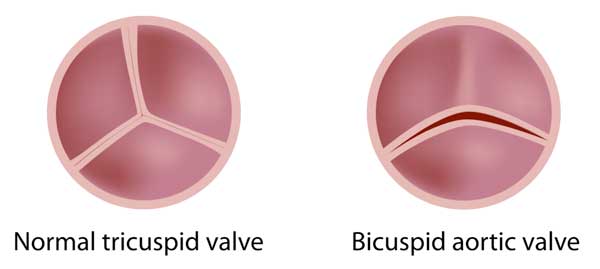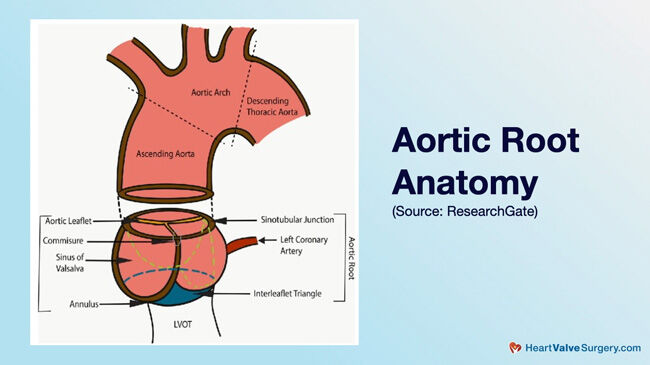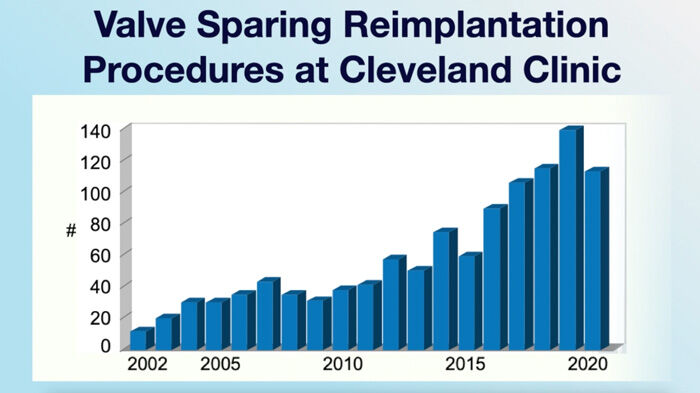Bicuspid Aortic Valve & Valve-Sparing Root Replacement: Top 8 Facts
Written By: Adam Pick, Patient Advocate & Author
Medical Expert: Eric Roselli, MD, Adult Chief of Cardiac Surgery, Cleveland Clinic
Published: February 22, 2023
Advanced surgical techniques are providing heart valve patients enhanced quality-of-life with more durable outcomes.
For example, young patients diagnosed with severe bicuspid aortic valve disease and aortic root aneurysms previously had limited treatment options that required complete replacement of the aortic valve and the aneurysm. Today, however, surgeons are using aortic valve reconstruction techniques to “spare” the patient’s native aortic valve tissue with the important goal of preserving natural valve functions without re-operations.
To learn about Valve-Sparing Root Replacement Procedures for bicuspid aortic valve patients, we interviewed Dr. Eric Roselli, the Adult Chief of Cardiac Surgery at the Cleveland Clinic. Having performed over 5,000 cardiac procedures, Dr. Roselli specializes in bicuspid aortic valve and aortic aneurysm surgery.
Key Learnings About Bicuspid Aortic Valve-Sparing Root Replacement
Here are important insights from Dr. Roselli about the advanced treatment of bicuspid aortic valves and aneurysms:
- Bicuspid aortic valve disease is prevalent and has a close relationship with aortic aneurysms. “About 2% of people have a bicuspid aortic valve,” states Dr. Roselli. “Between 30% and 50% of bicuspid aortic valve patients have what we call ‘aortopathy’ or a disease of the aorta that makes it prone to become an aneurysm or get enlarged.”

- If required, bicuspid aortic valves and aortic aneurysms can be safely treated during a single operation.
- Developing a treatment plan should be unique for each patient given the nature and variability of each disease and the desired long-term outcome. “We actually have to tailor it based on the details of the disease that we see,” states Dr. Roselli. “In other words, one or the other, the aorta or the valve, can be the thing that brings you to the operating room. We have to have a long-term view of each of those.”
- Heart valve replacement devices – tissue valves and mechanical valves – are good but have limitations.
- Dr. Roselli is adamant that, if possible, the patient’s own tissue should be “spared” to achieve the optimal result. “If we could save a living valve, that valve can handle the wear and tear of opening and closing a hundred thousand times better than the others, as long as it’s not started down a pathway of degeneration,” states Dr. Roselli.

- Valve-Sparing Root Replacement is a very complex procedure given all of the anatomical and hemodynamic (blood flow) considerations of a bicuspid aortic valve within the aortic root. “The valve is not just these moving parts like it is in a manmade valve where you got something on a hinge. The valve’s function is dependent upon all of those structures, the opening to the heart, the annulus, the sinuses of the root from which the valve is suspended. All those things need to all be aligned and come together in this really beautiful harmony for the valve to work well. If parts of that are abnormal, like the aneurysm, and yet parts of them are good, we can spare the good parts and reconstruct the bad parts,” states Dr. Roselli.
- The surgical outcomes for Valve-Sparing Root Replacement procedures have been excellent. Dr. Roselli states, “We do about 125 valve-sparing root replacement operations a year. About a quarter of those are in patients with bicuspid aortic valves. It’s at least several times a month. Our outcomes have been excellent.”

- Dr. Roselli leverages a “shared-decision making” approach with his patients and his medical team to identify and select the safest and most durable therapy available to the patient.
Many Thanks to Dr. Roselli and Cleveland Clinic
On behalf of our patient community, many thanks to Dr. Roselli for sharing his clinical experiences and research with us. We also want to thank the entire Cleveland Clinic team for taking such great care of patients with heart valve disease.
Related Links:
- See Dr. Eric Roselli’s Interactive Surgeon Profile
- Dr. Roselli’s Patient Success Story: Ari Mintzer
- Heart Surgery Innovations: Bicuspid Aortic Valve & Aortic Aneurysms with Dr. Eric Roselli
- Explore the Cleveland Clinic Heart Valve Microsite
Keep on tickin!
Adam
P.S. I have provided a written transcript of this video interview below for the the deaf and hard of hearing members of our community.
Video Transcript:
Adam Pick: Hi, everybody. It’s Adam at heartvalvesurgery.com. This is a very special surgeon question and answer session all about bicuspid aortic valves and valve-sparing aortic root replacement. I am thrilled to be joined by Dr. Eric Roselli, who is the Chief of Adult Cardiac Surgery at the Cleveland Clinic in Cleveland, Ohio. During his extraordinary career, Dr. Roselli has performed thousands of heart valve repair and heart valve replacement procedures. Dr. Roselli, thanks so much for being with us today.
Dr. Eric Roselli: Hi, Adam, great to be here.
Adam Pick: Dr. Roselli, given that we’ve known each other now for over 30 years, I’m going to call you Eric –
Dr. Eric Roselli: Please.
Adam Pick: For the rest of this conversation.
Dr. Eric Roselli: You knew me before I was a doctor. You should be calling me Eric, please.
Adam Pick: For everybody out there we met at the University of Michigan back in 1990 – and so we’ll say go blue one time for me.
Dr. Eric Roselli: Go blue.
Adam Pick: Eric, you can say –
Dr. Eric Roselli: Go blue.
Adam Pick: Go blue.
Dr. Eric Roselli: Go blue.
Adam Pick: Let’s get into it. Let’s get into it, Eric. At heartvalvesurgery.com, about 30% of the patients have bicuspid aortic valves, and 20% of patients have aortic aneurysms. These are both something that are your specialties there at the Cleveland Clinic. Can you maybe help them understand this unique association or relationship between a bicuspid aortic valve and an aneurysm?
Dr. Eric Roselli: Yeah. The aortic valve lives in the aorta. If you have an abnormal valve, it’s not surprising to know that a significant proportion of patients will also have a problem with the aorta. The two things really – they function together, they go together. Sometimes the diseases that affect one can affect the other. It’s not a straight connection though. It’s not necessarily a causative relationship as much as an associated relationship.
About 2% of people have a bicuspid aortic valve, and amongst them, somewhere between 30 and 50% of them will have what we call aortopathy or a disease of the aorta that makes it prone to become an aneurysm or get enlarged. Sometimes the two things go together at the same rate. Sometimes the aneurysm develops later. Sometimes it’s just the aneurysm involved, and the valve is working just fine. I guess the really reassuring thing is we can take care of both at the same time, just as safely as we do one by themselves.
Adam Pick: Eric, let’s get into that conversation about fixing or treating a bicuspid aortic valve and an aneurysm in one procedure. I’m curious to know, as I’m sure all the patients watching this, what is your recommended approach for treating a bicuspid aortic valve and an aneurysm?
Dr. Eric Roselli: We actually have to tailor it based on the details of the disease that we see. In other words, one or the other, the aorta or the valve, can be the thing that brings you to the operating room. We have to have a long-term view of each of those. In some patients where the bicuspid valve is functioning beautifully and the root of the aorta is a normal size and shape, and yet the aneurysm is sitting above – that goes with it. It’s the problem. We might just take care of the aneurysm, leave the valve alone. Leave a living valve alone.
Then in some people, the aneurysm doesn’t involve just the ascending aorta above the valve, but it can involve the root of the aorta where the valve lives. That’s got to all go, that abnormal aorta. If that valve, even bicuspid valve, looks like it’s healthy tissue in the leaflets, we can spare that valve and do what we call a valve-sparing root replacement operation, or David’s procedure. That’s a particularly complex operation, but something we’re seeing we’re doing more of, and so are some other centers.
Adam Pick: Eric, I love how you are tailoring different procedures for different patients with diseases that might be variable when you’re looking at them in the operating room. One of the questions that came out of your last discussion I’m sure patients are wondering is – valve-sparing, sparing the need of tissue. You are very adamant that that’s an optimal result here if possible. Can you tell the patients why that is such an important possibility for them and for their life?
Dr. Eric Roselli: Right now, the options for valve replacement are really good. They can take your heart and put it in a place where it has a well-functioning valve. The current options have limitations. Either you require blood thinners or the valve is going to wear out because it’s not alive, or you can have other issues even with Ross reconstruction, where you take a live valve but put a dead one in another position. There’s limitations to all those replacement options. If we could save a living valve, that valve can handle the wear and tear of opening and closing a hundred thousand times better than the others, as long as it’s not started down a pathway of degeneration.
A lot of patients who come to us with a bicuspid valve or other – the valve is leaking, but the parts themselves still look like healthy substrate to work with. We can reconstruct the aorta around it and put that living valve in a happier home and get it lined up in such a way that the mechanical stresses upon that living tissue are ideal. Hopefully, that translates into being a much more durable option for those subset of patients.
Adam Pick: Eric, you set the goal with the valve-sparing procedure if possible. You also talked earlier about the complexity of this procedure. I’m sure patients are wondering why is this more complex and where can I get this done. Maybe you can talk a little bit about your outcomes there at the Cleveland Clinic.
Dr. Eric Roselli: I’m going to get into some detail about it, because I think it’s important to understand. The valve is not just these moving parts like it is in a manmade valve where you got something on a hinge. The valve’s function is dependent upon all of those structures, the opening to the heart, the annulus, the sinuses of the root from which the valve is suspended. All those things need to all be aligned and come together in this really beautiful harmony for the valve to work well. If parts of that are abnormal, like the aneurysm, and yet parts of them are good, we can spare the good parts and reconstruct the bad parts. That’s the way we think about it.
In the aortic root, you’ve got all those moving parts. It’s a complex operation to put it back together and keep the living parts aligned in just the right way. That’s an area of expertise that you won’t find everywhere, although we’re seeing more and more, as the field has advanced, more and more surgeons are able to do these valve-sparing operations. It’s particularly complex in a bicuspid valve situation, and so specialized centers to do these more.
At the Cleveland Clinic, we do about 125 valve-sparing root replacement operations a year. About a quarter of those are in patients with bicuspid aortic valves. It’s at least several times a month. Our outcomes have been excellent.
Adam Pick: Eric, congratulations to you and your team there at the Cleveland Clinic on those outcomes you mentioned for valve-sparing procedures. I got to ask you this question, which I’m sure a lot of patients are wondering – is what advice might Eric/Dr. Roselli have for me the patient specific to a bicuspid aortic valve, an aneurysm, and the possibility of having a valve-sparing procedure?
Dr. Eric Roselli: It’s a complex decision-making process any time a person comes in with a bicuspid valve, especially when they’ve got the associated aneurysm. Then the question about complex treatment options like valve-sparing root replacement and valve repair throws a whole other element of complexity. My advice to the patients are bring as many questions as you need to the table to understand whether you’re a candidate for that, and know that it may be based on what you bring to the table as a patient with regards to what your valve or your aorta looks like, or even your own desires about lifestyle, and anticoagulation, etc.
That decision-making process also requires some input from the operating team and what they bring to the table. Ask them about their experience with the very different treatment options that you have available to you, why they think you may or may not be a candidate for the various options, and whether it’s based on issues that are related to you as the patient or issues related to them and their own outcomes and expertise in those areas. That should be an open discussion about all those different elements that come into play when you’re working as a team to make a decision about what’s best for you in a personalized way.
Adam Pick: I love how you’re encouraging patients to use a shared decision-making approach to their aortic valve and aneurysm diseases. I just want to take a minute to thank you for sharing all of your expertise with the entire heartvalvesurgery.com community. I really appreciate you taking time away from your very busy practice there at Cleveland Clinic to help us learn more about bicuspid aortic valves, aneurysms, and valve-sparing procedures. Thanks for being with us today.
Dr. Eric Roselli: Thanks, Adam. It’s always great to talk with you. I really appreciate being a part of this and helping to increase the knowledge in the space, empower our patients. It’s always great just to chat with you. Hopefully, we can get together live one of these days soon.





